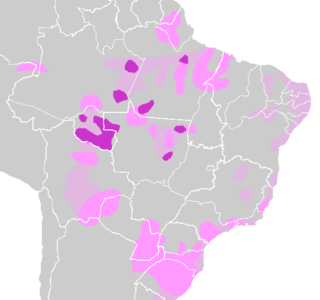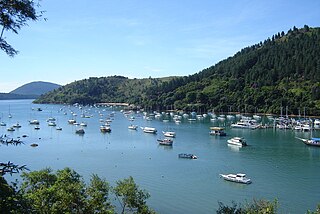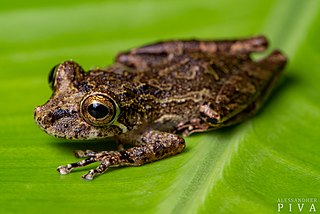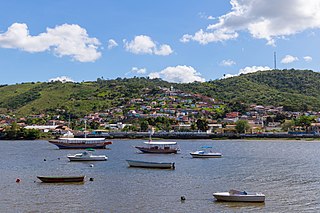
Tupi–Guarani is the most widely distributed subfamily of the Tupian languages of South America. It consists of about fifty languages, including Guarani and Old Tupi. The most widely spoken in modern times by far is Guarani, which is one of the two official languages of Paraguay.

Caramuru was the Tupi name of the Portuguese colonist Diogo Álvares Correia, who is notable for being the first European to establish contact with the native Tupinambá population in modern-day Brazil and was instrumental in the early colonization of Brazil by the Portuguese crown. Notably, Caramuru's native-born wife, Catarina Paraguaçu, was the first South American native to be received at the Palace of Versailles in 1526. He and Catarina would become the first Christian family in Brazil and have three children: Gaspar, Gabriel and Jorge, all named knights by Tomé de Sousa.

The Tupinambá are one of the various Tupi ethnic groups that inhabited present-day Brazil since before the conquest of the region by Portuguese colonial settlers. In the first years of contact with the Portuguese, the Tupinambás lived in the whole East coast of Brazil, and the name was also applied to other Tupi-speaking groups such as the Tupiniquim, Potiguara, Tupinambá, Temiminó, Caeté, Tabajara, Tamoio, and Tupinaé, among others.

Hans Staden was a German soldier and explorer who voyaged to South America in the middle of the sixteenth century, where he was captured by the Tupinambá people of Brazil. He managed to survive and return safe to Europe. In his widely read True History: An Account of Cannibal Captivity in Brazil, he claimed that the native people that held him captive practiced cannibalism.

The Nheengatu or Nenhengatu language, or Nenhengatu, also known as Modern Tupi and Amazonic Tupi, is a Tupi–Guarani language.
The Tupí or Tupinambá languages are a subgroup of the Tupi–Guarani language family.

Ubatuba is a Brazilian municipality, located on the southeast coast, in the state of São Paulo. It is part of the Metropolitan Region of Vale do Paraíba e Litoral Norte. The population is 92,819 in an area of 723.88 km2, of which 83% is located in the Serra do Mar State Park.

São Sebastião is a Brazilian municipality, located on the southeast coast of Brazil, in the state of São Paulo. The population in 2020 was 90,328, its density was 185/km2 and the area is 403 km2. The Tropic of Capricorn lies 25 km north. The municipality existed since 1636 and formed a part of the old hereditary captaincy of Santo Amaro.

How Tasty Was My Little Frenchman is a Brazilian black comedy directed by Nelson Pereira dos Santos released in 1971.
Ololygon alcatraz is a species of frog in the family Hylidae. It is endemic to Ilha dos Alcatrazes, an island off the coast of São Paulo state, Brazil. Common name Alcatraz snouted Treefrog has been coined for it.
Ololygon aromothyella is a species of frog in the family Hylidae, found in Argentina, Uruguay and Brazil.
Ololygon humilis, also known as the Rio Babi snouted treefrog, is a species of frog in the family Hylidae. It is endemic to the coastal lowlands of Rio de Janeiro in southeastern Brazil, as well as Espírito Santo and São Paulo.

Ololygon littoralis is a species of frog in the family Hylidae. It is endemic to Brazil. Its natural habitats are subtropical or tropical moist lowland forests and intermittent freshwater marshes. It is threatened by habitat loss.
Ololygon ranki is a species of frog in the family Hylidae. It is endemic to southeast Brazil. Its natural habitats are subtropical or tropical moist lowland forests and rivers. It is threatened by habitat loss.
Tupinambás Ecological Station is a marine ecological station in and around the Alcatrazes archipelago off the coast in São Paulo State, Brazil.

Salvador Flamenco Cabezas is a retired footballer from El Salvador.
Jorge Tupinambá dos Santos was a Brazilian professional football player and manager.

São Félix, Bahia is a municipality in Bahia, Brazil. The municipality has a population of 14,762 with a population density of 142 inhabitants per square kilometer. It is located 110 km (68 mi) from the state capital of Bahia, Salvador.

Ololygon is a genus of frogs in the family Hylidae. The majority of species in it are endemic to the Atlantic Forest of eastern Brazil, although the range of some species, including Ololygon aromothyella and Ololygon berthae, is known to extend south to northeastern Argentina, southern Paraguay, and Uruguay.










